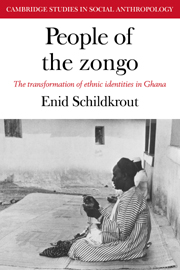Book contents
- Frontmatter
- Contents
- List of tables, figures, and maps
- Preface
- Glossary
- I Ethnicity and migration
- II Kinship and community
- 4 The growth of the zongo community in Kumasi
- 5 Ethnicity and the domestic context
- 6 Ethnicity and the idiom of kinship
- 7 Kinship and marriage in the second generation
- III Politics and change
- Notes
- Bibliography
- Index
4 - The growth of the zongo community in Kumasi
Published online by Cambridge University Press: 29 October 2009
- Frontmatter
- Contents
- List of tables, figures, and maps
- Preface
- Glossary
- I Ethnicity and migration
- II Kinship and community
- 4 The growth of the zongo community in Kumasi
- 5 Ethnicity and the domestic context
- 6 Ethnicity and the idiom of kinship
- 7 Kinship and marriage in the second generation
- III Politics and change
- Notes
- Bibliography
- Index
Summary
The northern Ghanaian and non-Ghanaian immigrants whose descendants are today referred to as members of the zongo community began to settle in Kumasi just before the beginning of this century, around 1896, when the British placed a Resident in the town. The word zongo, a Hausa term meaning the camping place of a caravan, or the lodging place of travellers (Abraham 1962: 967), was used by the British to refer to the section of the town where Muslim traders lived. It was used interchangeably with “Hausa settlement,” “Mohammedan settlement,” and “strangers' quarter.” The term Hausa was itself “a generic term used to refer to all up-country traders” (Annual Report, 1906–1907). In this chapter the history of the settlement of the zongo is described, and the several current usages of the term zongo are clarified. First, something must be said about the position of Muslims in Asante before the British conquered it and made Kumasi the administrative center of the Ashanti Crown Colony in 1901. In many ways there is a significant pattern of structural continuity in the position of strangers in the two periods. The British, and the Chief Commissioner in particular, replaced the central authority of the Asantehene, but the strangers remained in Asante under the patronage of the governmental authority in both the colonial and the precolonial periods.
- Type
- Chapter
- Information
- People of the ZongoThe Transformation of Ethnic Identities in Ghana, pp. 67 - 97Publisher: Cambridge University PressPrint publication year: 1978



